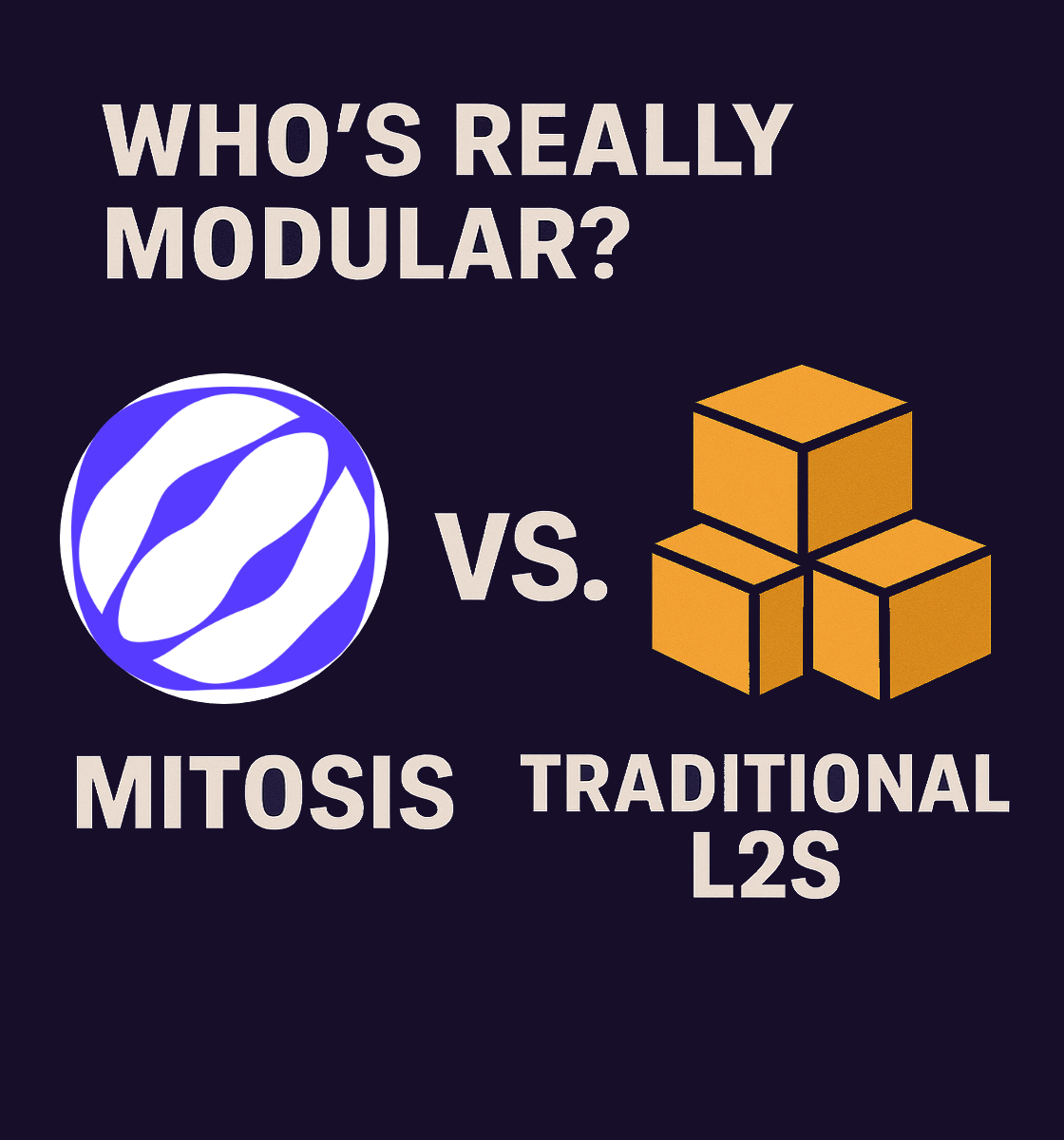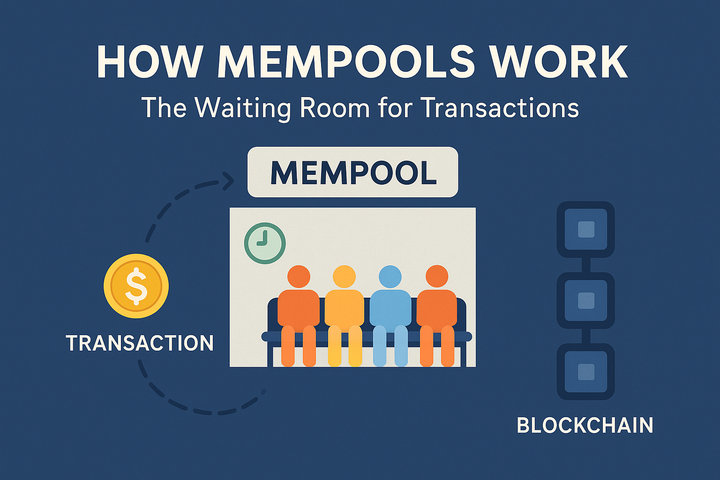Mitosis vs Traditional L2s: Who’s Really Modular?

The blockchain world is evolving rapidly, with modularity emerging as a cornerstone of scalable, interoperable ecosystems. Traditional Layer 2 (L2) solutions like Optimistic Rollups, ZK-Rollups, and sidechains have long been celebrated for separating transaction execution from Layer 1 (L1) blockchains like Ethereum, enabling faster and cheaper transactions. Enter Mitosis, a self-proclaimed "modular liquidity protocol" that promises to redefine modularity by addressing liquidity fragmentation and cross-chain inefficiencies. But who truly deserves the modular crown? This article compares Mitosis and traditional L2s across three core dimensions (functional separation, interoperability, and liquidity management), exploring how each approach shapes the future of decentralized finance (DeFi).
Understanding Modularity in Blockchains: Functional Separation
Modularity in blockchain design refers to separating core functions into distinct layers, allowing each to operate independently and be optimized for specific tasks. This contrasts with monolithic architectures (e.g., traditional Layer 1s like Ethereum or Bitcoin), where all functions from execution (processing transactions), consensus (agreeing on the state), data availability (ensuring data is accessible), and settlement (finalizing transactions) are handled by a single chain. Modular blockchains enhance scalability, flexibility, and interoperability by decoupling these components. Traditional L2s are already considered modular to some extent because they offload execution (and sometimes data availability) from Layer 1 (L1) blockchains like Ethereum, relying on the L1 for consensus and settlement. For example:
- Optimistic Rollups (Arbitrum, Optimism): Optimistic rollups execute transactions off-chain, batch them, and submit compressed data to L1 for settlement. They assume transactions are valid unless challenged (fraud proofs).
- ZK-Rollups (zkSync, StarkNet): Also execute transactions off-chain but use zero-knowledge proofs to verify correctness, posting minimal data to L1.
- Sidechains (Polygon PoS): Operate as independent blockchains with their consensus but connect to L1 via bridges for asset transfers.
- State Channels (Lightning Network): State Channels handle transactions off-chain with periodic L1 settlement.
Each of these L2 solutions separates execution from the L1, making them inherently modular compared to monolithic L1s. The question is whether Mitosis takes modularity further or in a different direction.
Enter Mitosis,
This L1 pushes modularity further with a dual-layer architecture: a Cosmos-based consensus layer for scalability and an EVM-compatible execution layer for Ethereum interoperability. This design decouples consensus from execution, allowing each to be optimized independently. Unlike traditional L2s, Mitosis leverages shared security models like EigenLayer, reducing the need for its consensus overhead while maintaining Ethereum’s robustness. By treating these functions as distinct, interoperable components, Mitosis offers a more granular approach to modularity, potentially enabling greater customization for developers and users. However, its reliance on Cosmos and EigenLayer introduces dependencies that could complicate its ecosystem if those platforms face challenges.
Interoperability: Bridging the Gap
Interoperability is a critical challenge in the modular blockchain era, as siloed L2s fragment ecosystems and hinder seamless asset movement. Traditional L2s struggle here. Moving assets between Arbitrum and Optimism, or from an L2 to Ethereum, often requires bridges (intermediaries that introduce latency, fees, and security risks). Bridge hacks, like the $600 million Ronin exploit in 2022, highlight these vulnerabilities. Sidechains like Polygon PoS are more autonomous but still rely on bridges for L1 connectivity, creating bottlenecks that disrupt user experience and DeFi efficiency. This lack of native interoperability undermines the modularity of traditional L2s, as their ecosystems remain largely isolated despite their scalability benefits. Mitosis tackles this head-on with a bridgeless liquidity layer designed to enable seamless asset movement across L2s, rollups, and appchains. By integrating with cross-chain messaging protocols like Hyperlane, Mitosis facilitates direct communication between modular ecosystems, bypassing the need for traditional bridges. This approach not only reduces security risks but also enhances user experience by enabling near-instant cross-chain interactions. Mitosis’s focus on interoperability aligns with the modular vision of a composable blockchain ecosystem, where chains operate as interconnected modules.
Liquidity Management: Unifying the DeFi Landscape
Liquidity fragmentation is a persistent pain point in DeFi, as assets locked in one L2’s ecosystem, say, a Uniswap pool on Optimism, are inaccessible to another, like StarkNet, without costly bridging. Traditional L2s exacerbate this issue because each operates as a distinct ecosystem with its liquidity pools. This siloing reduces capital efficiency, as liquidity providers must duplicate efforts across chains, and users face higher slippage or fees when accessing fragmented markets. While solutions like cross-chain DEX aggregators exist, they still rely on bridges, inheriting their inefficiencies and risks. Traditional L2s, despite their modularity in execution, lack a native mechanism to unify liquidity across ecosystems.
Mitosis’s defining feature is its modular liquidity framework, which treats liquidity positions (e.g., LP tokens from DeFi protocols) as programmable, interoperable assets. Dubbed “ecosystem-owned liquidity,” this model allows liquidity to flow seamlessly across L2s, rollups, and appchains, enabling DeFi protocols to tap into a shared liquidity pool without redundant deployments. For instance, a liquidity provider could stake assets in a pool that serves multiple chains simultaneously, maximizing efficiency. By combining this with its bridgeless architecture, Mitosis addresses fragmentation directly, offering a level of modularity that traditional L2s can’t match.
Who’s Really Modular?
Traditional L2s are modular in that they separate execution from other blockchain functions, relying on L1 for consensus, settlement, and (usually) data availability. This has been a game-changer for scaling Ethereum and other L1s, but it comes with limitations: siloed ecosystems, bridge dependencies, and liquidity fragmentation. Mitosis takes modularity to the next level by:
- Decoupling consensus and execution using a Cosmos-based and EVM-compatible stack.
- Treating liquidity as a modular, programmable component that can be shared across ecosystems.
- Prioritizing interoperability through bridgeless asset movement and cross-chain messaging.
- Leveraging shared security to avoid redundant consensus overhead.
While traditional L2s laid the groundwork for modularity by offloading execution, Mitosis extends this concept to liquidity and interoperability, addressing pain points that L2s have struggled with. Its resemblance to projects like Celestia (modularity), Hyperlane (cross-chain messaging), and Curve/Balancer (liquidity design) suggests it’s composing existing ideas into a novel framework.
Conclusion
As blockchain infrastructure matures, modularity is no longer a nice-to-have; it's becoming a foundational principle for scalability, composability, and user experience in DeFi. Traditional L2s like Optimistic Rollups, ZK-Rollups, and sidechains have made tremendous strides in scaling throughput by separating execution from consensus and settlement. However, their modularity often stops at execution, leaving significant gaps in cross-chain interoperability and liquidity efficiency. Mitosis enters this landscape not just as another modular solution, but as a reimagining of what modularity can be. Its dual-layer architecture separates consensus and execution more deliberately than traditional L2s, allowing independent optimization while leveraging Ethereum’s security through EigenLayer. This decoupling lays the groundwork for a more flexible and developer-friendly architecture. But Mitosis’s most significant contribution is its approach to interoperability and liquidity. By eliminating bridges and embracing cross-chain messaging protocols like Hyperlane, it minimizes the security risks and friction that have plagued L2 interactions. More importantly, its modular liquidity framework transforms liquidity from a chain-specific asset into a composable primitive, unlocking new efficiencies for liquidity providers and DeFi protocols alike.



Comments ()